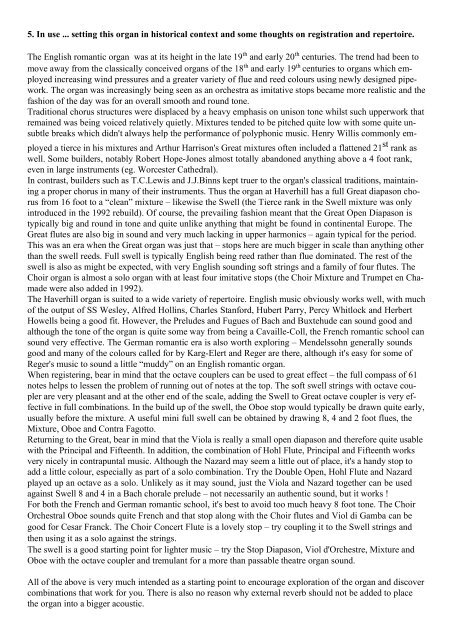Haverhill OIC MiniSet User Manual - Leyman Music
Haverhill OIC MiniSet User Manual - Leyman Music
Haverhill OIC MiniSet User Manual - Leyman Music
- No tags were found...
Create successful ePaper yourself
Turn your PDF publications into a flip-book with our unique Google optimized e-Paper software.
5. In use ... setting this organ in historical context and some thoughts on registration and repertoire.The English romantic organ was at its height in the late 19 th and early 20 th centuries. The trend had been tomove away from the classically conceived organs of the 18 th and early 19 th centuries to organs which employedincreasing wind pressures and a greater variety of flue and reed colours using newly designed pipework.The organ was increasingly being seen as an orchestra as imitative stops became more realistic and thefashion of the day was for an overall smooth and round tone.Traditional chorus structures were displaced by a heavy emphasis on unison tone whilst such upperwork thatremained was being voiced relatively quietly. Mixtures tended to be pitched quite low with some quite unsubtlebreaks which didn't always help the performance of polyphonic music. Henry Willis commonly employeda tierce in his mixtures and Arthur Harrison's Great mixtures often included a flattened 21 st rank aswell. Some builders, notably Robert Hope-Jones almost totally abandoned anything above a 4 foot rank,even in large instruments (eg. Worcester Cathedral).In contrast, builders such as T.C.Lewis and J.J.Binns kept truer to the organ's classical traditions, maintaininga proper chorus in many of their instruments. Thus the organ at <strong>Haverhill</strong> has a full Great diapason chorusfrom 16 foot to a “clean” mixture – likewise the Swell (the Tierce rank in the Swell mixture was onlyintroduced in the 1992 rebuild). Of course, the prevailing fashion meant that the Great Open Diapason istypically big and round in tone and quite unlike anything that might be found in continental Europe. TheGreat flutes are also big in sound and very much lacking in upper harmonics – again typical for the period.This was an era when the Great organ was just that – stops here are much bigger in scale than anything otherthan the swell reeds. Full swell is typically English being reed rather than flue dominated. The rest of theswell is also as might be expected, with very English sounding soft strings and a family of four flutes. TheChoir organ is almost a solo organ with at least four imitative stops (the Choir Mixture and Trumpet en Chamadewere also added in 1992).The <strong>Haverhill</strong> organ is suited to a wide variety of repertoire. English music obviously works well, with muchof the output of SS Wesley, Alfred Hollins, Charles Stanford, Hubert Parry, Percy Whitlock and HerbertHowells being a good fit. However, the Preludes and Fugues of Bach and Buxtehude can sound good andalthough the tone of the organ is quite some way from being a Cavaille-Coll, the French romantic school cansound very effective. The German romantic era is also worth exploring – Mendelssohn generally soundsgood and many of the colours called for by Karg-Elert and Reger are there, although it's easy for some ofReger's music to sound a little “muddy” on an English romantic organ.When registering, bear in mind that the octave couplers can be used to great effect – the full compass of 61notes helps to lessen the problem of running out of notes at the top. The soft swell strings with octave couplerare very pleasant and at the other end of the scale, adding the Swell to Great octave coupler is very effectivein full combinations. In the build up of the swell, the Oboe stop would typically be drawn quite early,usually before the mixture. A useful mini full swell can be obtained by drawing 8, 4 and 2 foot flues, theMixture, Oboe and Contra Fagotto.Returning to the Great, bear in mind that the Viola is really a small open diapason and therefore quite usablewith the Principal and Fifteenth. In addition, the combination of Hohl Flute, Principal and Fifteenth worksvery nicely in contrapuntal music. Although the Nazard may seem a little out of place, it's a handy stop toadd a little colour, especially as part of a solo combination. Try the Double Open, Hohl Flute and Nazardplayed up an octave as a solo. Unlikely as it may sound, just the Viola and Nazard together can be usedagainst Swell 8 and 4 in a Bach chorale prelude – not necessarily an authentic sound, but it works !For both the French and German romantic school, it's best to avoid too much heavy 8 foot tone. The ChoirOrchestral Oboe sounds quite French and that stop along with the Choir flutes and Viol di Gamba can begood for Cesar Franck. The Choir Concert Flute is a lovely stop – try coupling it to the Swell strings andthen using it as a solo against the strings.The swell is a good starting point for lighter music – try the Stop Diapason, Viol d'Orchestre, Mixture andOboe with the octave coupler and tremulant for a more than passable theatre organ sound.All of the above is very much intended as a starting point to encourage exploration of the organ and discovercombinations that work for you. There is also no reason why external reverb should not be added to placethe organ into a bigger acoustic.



